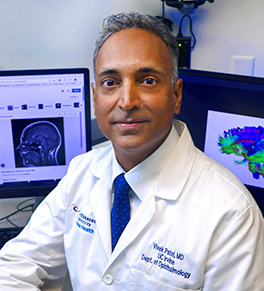
Essential Tremor
It feels embarrassing to shake uncontrollably in social situations. Our UCI Health movement disorders specialists can help.
While not curable, the right medications or surgical interventions can make a meaningful difference.
Signs and symptoms of essential tremor
Essential tremor is the most common movement disorder in the U.S. Though tremor is involved, it is very different from Parkinson’s disease because it does not cause stiffness or slow movements. While it can happen at any age, it tends to emerge later in life.
Symptoms may include:
- Tremor in different parts of the body, especially when making purposeful movements
- A quivering voice
- Tremor that worsens with age
When to seek care
If you have noticed a trembling starting in different parts of your body, including your speech, see your doctor. For the most tailored care, your primary care doctor should refer you to a neurologist. Treating essential tremor is a large part of our practice at the UCI Health Parkinson’s and Movement Disorders Program.Essential tremor diagnosis at UCI Health
We’ll give you a thorough clinical evaluation. This will include:
- Your complete medical history
- A family medical history
- An assessment of any current medications
- We look for evidence of other movement disorders
- MRI and CT imaging scans don’t diagnose essential tremor but help us rule out other tremor causes
Essential tremor can be mistaken for or misdiagnosed as Parkinson’s disease. Despite essential tremor being the most common movement disorder in the general population, a proper diagnosis, including the ability to rule out other disorders, is vital.
Our movement disorder doctors are fellowship trained experts who are experienced at making these essential distinctions. Please come in for an evaluation even if your trembling symptoms seem mild.
Essential tremor treatment at UCI Health
Because these disorders affect so many systems in the body, our work in movement disorders requires a multidisciplinary team approach. Our movement disorder neurologists collaborate with neurosurgeons, imaging specialists, language and speech pathologists and physical therapists.
While there is no cure for essential tremor, we offer different therapies and approaches that relieve symptoms. Our neurologists create a personalized care plan for you to reduce the frequency of your tremors. That could include:
Medications
- Beta blockers
- Anti-seizure or anticonvulsant medications
- Anti-anxiety drugs
- Botulinum toxin injections can sometimes be considered
Surgery
If your tremor is disabling and non-surgical interventions (medications) haven’t helped or cannot be used, surgery may be right for you.
Types of surgical procedures
In your brain, the thalamus plays a role in controlling movement. We focus our surgeries on the thalamus with:
- Image-guided focused ultrasound thalamotomy, which uses soundwaves to lesion a small portion of the thalamus
- Deep brain stimulation (DBS) involves implanting a pacemaker-like device in the chest. This will regulate electrical activity in the thalamus through leads.
- Stereotactic thalamotomy, which uses radiation to lesion a small part of the thalamus
Rehabilitative therapies
We may recommend you work with a speech or physical therapist. They can help you with vocal control or muscle strengthening.
Our goal is to make sure you get the best care with the fewest side effects.
Why choose UCI Health for essential tremor?
Our neurologists are hyper-specialized within many subspecialties
The amount of knowledge that gets discovered in neuroscience doubles every 70 days. Our specialization in movement disorders is a great advantage. We want you to have access to the best experts available.
Our doctors draw upon all treatment methods including exercise and rehabilitative therapies for tremor reduction balance and speech
When appropriate, we also offer advanced therapies, including deep brain stimulation (DBS) and focused ultrasound.
You’re unique and whole, not just a diagnosis
Our philosophy is to care about you as our patient and keep you at the center of our focus. We recognize how much our work impacts your life, and routinely engage in compassionate listening.

Involuntary shaking creates anxiety
The best way to restore your confidence is to reduce your essential tremor symptoms with expert help.
Call 714-456-7720 and speak with a movement disorder specialist.

Find a neurology clinical trial
Talk to your doctor to see if a neurology clinical trial is right for you.
Featured Blog Posts

Parkinson’s disease: Knowledge is power

UCI Health — Irvine opens its doors

Eyes are a window into the brain
Upcoming Events
Parkinsons Wellness Program
5-6 p.m.
Parkinson's Disease Support Group
The UCI Health Parkinson's Disease Support group provides a place where patients can discuss their diagnosis, treatments, etc.




